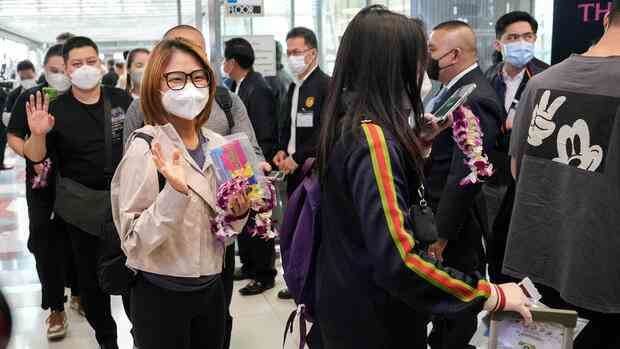Bangkok Xiamen Airlines flight MF833 brings 269 passengers to the Thai capital Bangkok – and the hope for an end to the tourism crisis that has been going on for three years. The visitors from southeast China were the first holidaymakers from the People’s Republic to travel to the Southeast Asian holiday country after China opened the border on Monday. Three Thai ministers came to the airport to greet them. “Thailand welcomes family members from China,” read a red banner several meters long.
Thailand’s Deputy Prime Minister Anutin Charnvirakul said he expects the number of Chinese vacationers to rise steadily again with the end of the corona travel restrictions imposed in Beijing. This is a good sign for his country and the income opportunities of the population, he stressed.
In view of the enormous economic importance of China’s holidaymakers, the relief is understandable: According to United Nations data, in the year before the corona pandemic they spent 255 billion dollars on trips abroad – more than any other country. And nowhere else have people benefited from the growing desire to travel among the Chinese as much as in Thailand.
Thailand expects more than 20 million tourists
In 2019, the peak so far, more than eleven million guests from China came to the tropical country – almost one million travelers per month. Thailand was the undisputed leader on the list of the most popular travel destinations for the Chinese. Economists estimate that around three and a half percent of Thailand’s economic output was due to visitors from China alone.
Top jobs of the day
Find the best jobs now and
be notified by email.
But the pandemic almost completely dried up the important source of income for three years. Hotels, restaurants and attractions that catered to the Chinese clientele had to close in droves – thousands lost their jobs.
>> Read here: China’s corona easing boosts tourism – Lufthansa is checking more flights
The country’s economy is now hoping for a turnaround: economists at Bangkok’s Krungthai Bank expect that after the quarantine regulations in China have been abolished, 4.8 million holidaymakers from the country will come to Thailand this year. The total number of Thailand tourists is likely to rise above the 20 million mark again in 2023 – in 2022 only half as many visitors came to the country.
But Southeast Asia’s second largest economy is still a long way from the record numbers of 2019, when Thailand welcomed around 40 million guests in one year. Krungthai economist Phacharaphot Nuntramas believes that this value will not be reached again until 2025 at the earliest. In the short term, the economic boost from China is likely to be only moderate: the government expects only 300,000 Chinese holidaymakers for the first quarter.
Above all, the lack of flight connections is still slowing down business: last Sunday – the day on which China lifted the Covid travel restrictions – only 245 international flights took off in the country. That was 90 percent less than on the same day three years ago.
Entry rules cause confusion
In Thailand, uncertainty about the entry regulations there is also causing a bumpy restart of mass tourism: In view of the wave of corona infections in China, the authorities in Bangkok last week reactivated the rule that only vaccinated travelers should be allowed into the country.
After an outcry from the tourism industry, the government withdrew this measure on Monday. But the damage had already been done by then. German tour operators alone have canceled several thousand room reservations, the tourism association on the holiday island of Phuket complained.
>> Read here: Not an easy partner: the EU wants to develop relations with Southeast Asia
In addition to the self-created problems, the global economy in particular threatens to spoil the hoped-for strong upswing. Because while tourism is slowly recovering, Thailand’s second economic pillar – the export business – is collapsing. According to preliminary figures, the value of exported goods fell by around six percent in the fourth quarter of last year compared to the previous year.
The strength of the Thai baht, which appreciated more than any other currency in Asia in the past six months, is adding to the difficulties, the exporters’ association TNSC complains. The local banking association is also concerned about the development, which is endangering the competitiveness of the industry.
In view of the problems, economists expect that Thailand will continue to be among the bottom ranks in the region, despite the positive development in the tourism business. The World Bank recently reduced its growth forecast for Thailand by 0.7 percentage points to 3.6 percent.
Among the Southeast Asian Asean countries, the expected growth rate is only lower in civil war-torn Myanmar. The weakest section of the population in particular is suffering from the sluggish economic situation: The World Bank economists are assuming an increasing poverty rate in Thailand – and warn that the government lacks the financial leeway to combat the problem effectively.
More: Germans can enjoy retirement in these eight countries
